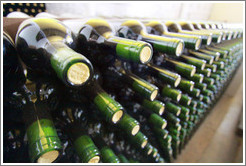Mendoza is Argentina's most famous wine producing region; in fact, it's the largest viticultural area in Latin America. Malbec, Argentina's "signature" wine, is the most common varietal, but a range of reds and whites are produced. Mendoza is arid, and wineries have to follow strict rules about irrigation. One big concern in Mendoza is hail; the occasionally enormous hail stones pose a threat to vine survival, and many vineyards have been protected with hail nets. The city of Mendoza itself is nothing special; it's a good base for visiting wineries but not for much else.
 Hail nets protecting vertical shoot positioned malbec vines.
Hail nets protecting vertical shoot positioned malbec vines.
 |
 |
| Malbec Leaf |
Cabernet Sauvignon Leaf |
Luján de Cuyo
This sub-region of Mendoza was the first appellation in Argentina. Altitudes average about 1000 meters above sea level.
Kaiken
Named after a species of migrating bird, Kaiken is Aurelio Montes' foray into Argentina. (Montes is, of course, an internationally renowned Chilean winemaker.) The winery, which produces two million bottles of wine annually, sources grapes from a number of vineyards across the Mendoza region.
|






|
Roberto Bonfanti
Tours at this boutique, family-owned winery are given by the winemakers themselves. Bonfanti produces only 50,000 bottles per year. The wines are complex and very good -- the best I had in Mendoza.
|






|
Lagarde
This beautiful winery, founded in 1897, retains many of its original elements. In addition to producing excellent wines (two million bottles per year), Lagarde makes exquisite olive oils. Its restaurant, featuring perfect wine pairings, is highly recommended, and its courtyard is a lovely place to have lunch. When the current owners purchased this winery, they found a large barrel of wine over a century old; bottles of this wine are sold for a mere 300 Argentine pesos (about 75 US dollars).
|







|
Valle de Uco
This area is higher in altitude than Luján de Cuyo, with some mountain wineries as high as 1400 meters above sea level.
Domaine Jean Bosquet
Domaine Jean Bosquet produces a variety of excellent wines, many of them organic, and some under different names for foreign markets. The tour offered by this winery is enjoyable and detailed, showing much of the production process. Part of the area is under construction, as Domaine Jean Bosquet expands its production facilities; the dug-out area shows the depth of the sandy soil.
|








|
Andeluna
Andeluna produces quality wines, but it is much more commercial and its wines are higher-priced that those of other Mendoza wineries. The tour of this winery is very well-organized but unsatisfying and impersonal; for example, you view the cellar though a window without the pleasure of walking among and enjoying the scent of the barrels.
|








|
Mendoza (City)
This city is nothing special. Few old buildings remain due to a major earthquake in 1920. In a region with such high-caliber wineries, I expected the main city to be a little more chic and gastronomically pleasing. But it's just a normal city, with people throwing garbage out the windows of their cars like they do in Buenos Aires.






|
|
